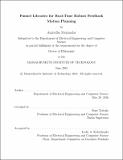| dc.contributor.advisor | Russ Tedrake. | en_US |
| dc.contributor.author | Majumdar, Anirudha | en_US |
| dc.contributor.other | Massachusetts Institute of Technology. Department of Electrical Engineering and Computer Science. | en_US |
| dc.date.accessioned | 2016-12-22T15:48:39Z | |
| dc.date.available | 2016-12-22T15:48:39Z | |
| dc.date.copyright | 2016 | en_US |
| dc.date.issued | 2016 | en_US |
| dc.identifier.uri | http://hdl.handle.net/1721.1/106033 | |
| dc.description | Thesis: Ph. D., Massachusetts Institute of Technology, Department of Electrical Engineering and Computer Science, 2016. | en_US |
| dc.description | This electronic version was submitted by the student author. The certified thesis is available in the Institute Archives and Special Collections. | en_US |
| dc.description | Cataloged from student-submitted PDF version of thesis. | en_US |
| dc.description | Includes bibliographical references (pages 125-136). | en_US |
| dc.description.abstract | We consider the problem of generating motion plans for a robot that are guaranteed to succeed despite uncertainty in the environment, parametric model uncertainty, and disturbances. Furthermore, we consider scenarios where these plans must be generated in real-time, because constraints such as obstacles in the environment may not be known until they are perceived (with a noisy sensor) at runtime. Our approach is to pre-compute a library of "funnels" along dierent maneuvers of the system that the state is guaranteed to remain within (despite bounded disturbances) when the feedback controller corresponding to the maneuver is executed. The resulting funnel library is then used to sequentially compose motion plans at runtime while ensuring the safety of the robot. A major advantage of the work presented here is that by explicitly taking into account the eect of uncertainty, the robot can evaluate motion plans based on how vulnerable they are to disturbances. We demonstrate and validate our method using extensive hardware experiments on a small fixed-wing airplane avoiding obstacles at high speed (~12 mph), along with thorough simulation experiments of ground vehicle and quadrotor models navigating through cluttered environments. To our knowledge, the resulting hardware demonstrations on a fixed-wing airplane constitute one of the first examples of provably safe and robust control for robotic systems with complex nonlinear dynamics that need to plan in realtime in environments with complex geometric constraints. The key computational engine we leverage is sums-of-squares (SOS) programming. While SOS programming allows us to apply our approach to systems of relatively high dimensionality (up to approximately 10-15 dimensional state spaces), scaling our approach to higher dimensional systems such as humanoid robots requires a dierent set of computational tools. In this thesis, we demonstrate how DSOS and SDSOS programming, which are recently introduced alternatives to SOS programming, can be employed to achieve this improved scalability and handle control systems with as many as 30-50 state dimensions. | en_US |
| dc.description.statementofresponsibility | by Anirudha Majumdar. | en_US |
| dc.format.extent | 136 pages | en_US |
| dc.language.iso | eng | en_US |
| dc.publisher | Massachusetts Institute of Technology | en_US |
| dc.rights | M.I.T. theses are protected by copyright. They may be viewed from this source for any purpose, but reproduction or distribution in any format is prohibited without written permission. See provided URL for inquiries about permission. | en_US |
| dc.rights.uri | http://dspace.mit.edu/handle/1721.1/7582 | en_US |
| dc.subject | Electrical Engineering and Computer Science. | en_US |
| dc.title | Funnel libraries for real-time robust feedback motion planning | en_US |
| dc.type | Thesis | en_US |
| dc.description.degree | Ph. D. | en_US |
| dc.contributor.department | Massachusetts Institute of Technology. Department of Electrical Engineering and Computer Science | |
| dc.identifier.oclc | 965380239 | en_US |
